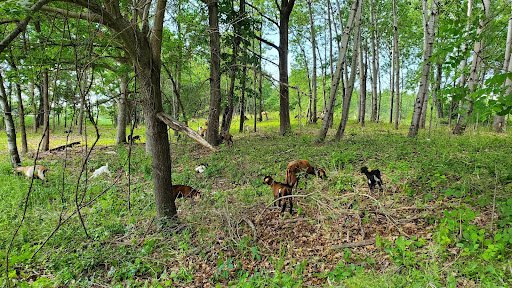MN Invasive Terrestrial Plants & Pests Center (MITPPC)
Summary by Angela Gupta, UMN Extension Forester, agupta@umn.edu
Last June the MITPPC produce a white paper, Managing Invasive Buckthorn, summarizing buckthorn management research that can help woodland owners and land managers. The report includes buckthorn identification, types of removal options including goats, and prevention strategies.
MITPPC researchers have seen that planting native grasses, wildflowers, sedges, and ferns can cut the amount of returning buckthorn in half over a few-year period. Scientists have also seen the greatest reduction in buckthorn reinvasion with planting trees or shrubs, which can reduce the amount of returning buckthorn by up to 90%. In addition to helping keep buckthorn at bay, this method can improve and diversify the native plant community, reduce herbicide use, and result in significant cost and labor savings for large-scale property managers and individual homeowners alike (page 4).
Goats are a crowd favorite when doing buckthorn management; this paper does a good job of outlining the pros and cons of goat grazing on buckthorn. The paper reminds readers that goats are just one tool in the toolbox that will likely need to be used with other tools to have long-term buckthorn management success. One interesting finding:
“Researchers have found, however, that goats are at a higher risk of contracting the parasite meningeal worm late summer and into fall. This parasite is found in slugs and snails and causes neurologic disease and death in goats, sheep, llamas, and alpacas. But MITPPC scientists have also found that co-grazing goats alongside waterfowl (like ducks and geese) may help minimize the goats’ exposure to meningeal worm because the waterfowl, which are not susceptible to the meningeal worm, will eat the snails and slugs that can carry the parasite (page 9).
Photos by A. Gupta, UMN Extension
The preventing buckthorn reinvasion section on page 10 offers the newest information. Building on the data that more native vegetation reduces light availability for buckthorn and thus reduces buckthorn regrowth, there are recommendations for trees, shrubs, grasses, and wildflowers that have established and reduced buckthorn regeneration. Specific examples are balsam fir (Abies balsamea), sugar maple (Acer saccharum), red and common Elderberry (Sambucus racemosa and Sambucus canadensis), wild rye grass species (Elymus spp.) and native wildflowers planted densely. One interesting point is that revegetating native grasses may enable enough fuel for spring-prescribed burns which can help to manage young buckthorn.
This 14-page white paper is a fast and easy read for anyone interested in the newest research on buckthorn management. Enjoy.

